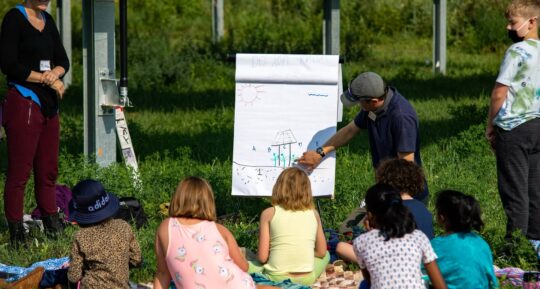Solar Farming Protects Rural Character
In Colorado, Jack’s Solar Garden pairs traditional farming with solar energy production.

The San Juan County Comprehensive Plan calls for rural character and advocates for energy independence. Increasing local energy production, especially in partnership with the farming community, not only reduces our dependence on the mainland for electricity but also protects rural character.
The National Academy of Sciences estimates climate destruction could result in the extinction of one-third of all animal and plant species on Earth within 50 years.
As we witness fires in Los Angeles, floods in Asheville, North Carolina, and storms in Florida, we know no place on Earth is immune to these tragic disasters.
San Juan County will face its own forms of extreme heat, drought, wind, wildfires, rain, flooding, sea-level rise and climate migration. This accelerating climate destruction threatens cherished rural character and the fragile Salish Sea.
The key to decelerating destruction is to stop burning fossil fuels and replace the power generated with renewable energy. Washington aims to cut fossil fuel pollution in half by 2030, just five years away.
Utilities nationwide have plans to deploy new renewable energy sources, but they are stuck in bureaucratic permitting processes. More than 70% of projects are canceled due to permitting delays, driven mainly by public NIMBY—not in my back yard—attitudes.
When replacing mainland fossil fuel power, an agrisolar project the size of the Bailer Hill Microgrid is the equivalent of planting 44,000 trees annually, growing for 10 years.
Agrisolar: Helping Farmers Steward Our Rural Lands
Oregon, New Jersey and Germany are at the forefront of agrisolar innovation. The three have successfully paired agriculture and solar energy production, which enhances the land, boosts farming economics and increases local renewable energy generation.
New Jersey has implemented a climatefriendly policy that incentivizes agrisolar arrays on up to 5% of farmland in a county.
Agrisolar helps farmers cultivate crops or graze livestock beneath solar panels, creating a symbiotic relationship that enhances land use; boosts crop yields, pollinators and soil fertility; and reduces evaporation, a critical benefit during climate-driven drought.
Jack’s Solar Garden in Colorado stands as an agrisolar beacon. Beginning in 1972, Jack Stingerie farmed hay and wheat to support his family. Hay production continued even though it became increasingly difficult to make ends meet on his 24-acre farm.
In 2021, Jack’s grandson, Byron Kominek, implemented agrisolar practices and turned the farm around. Since then, the farm has produced more than 25,000 pounds of vegetables, herbs and berries, demonstrating enhanced agricultural production, economics and soil fertility alongside renewable energy generation.
Agrisolar Offers Economic Resilience
According to the Department of Agriculture, the average San Juan County farmer loses $51 per acre each year.
In addition to increasing food production and soil health, agrisolar helps farmers strengthen their financial stability by diversifying income sources while reducing climate pollution. Agrisolar has the potential to generate up to $10,000 per acre annually at current market rates.
Agrisolar is a proactive step toward a sustainable and prosperous future. This dual-use approach helps rural communities preserve their landscapes, strengthen their economies, grow more food and contribute to a healthier planet.
The path forward is bright, with agrisolar lighting the way toward a harmonious balance between tradition and innovation.
■


